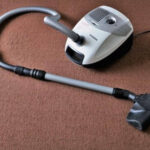You want to tumble dry your garment then you decide to do the right thing first: check the care label. There, you notice something you are not accustomed to and you simply begin to wonder what it means. So, what does line dry mean?
Line drying clothes means hanging your garments on a clothesline indoors or outdoors to dry. Simply put, if your clothes have this as the recommended drying method on the care label, do not throw them into the dryer. Further, do not dry them flat on a drying rack or table. Use clothespins to hang them on the line and position it in a place with proper circulation of air.
Hanging clothes where they can receive sunlight works well for most garments. That being said, you have to be keen on clothes that can be ruined by direct sunlight. Preferably, position a portable clothesline under a shade and hang them there. Alternatively, use a drying rack to accomplish the same purpose either indoors or outdoors.
Line Drying

I grew up in upcountry and line drying clothes was the norm. Literally, every home had several clotheslines, the T-pole type where you have multiple lines in between two poles with a t-shape at the top. And this was not even the case for some homes. Clotheslines were supported by two trees that stood directly opposite of each other.
Back then, dryers were rare (at least in my village) and only reserved for the well up families. Interestingly, even the fancy rotary/umbrella clotheslines and drying racks that are common today were uncommon. To be honest, this was not a big deal because it bothered nobody.
Fast-forward, line drying clothes is unpopular in many parts of the US today. While some neighborhoods have ridiculous regulations against the practice, there are people that associate outdoor clotheslines with poverty and unsightliness.
Not to mention, a lot has changed in terms of housing especially in urban areas. If you live in an apartment or a house with a small lawn, there is no doubt you have limited or no space for an outdoor clothesline.
But let’s face it, there is nothing wrong with line drying clothes. In fact you cannot convince some people to dry their clothes in a different way. And with increasing energy conservation concerns many people are acknowledging the usefulness of line drying.
How to Line Dry Properly

The care label tells you to line dry, but it doesn’t tell you how to do it. But line drying isn’t just hanging your clothes on a clothesline. If you are new to this, you could use some tips so that all you clothes can come out looking good in the end.
Step #1: Line drying can make some clothes and towels stiff. Avoid this by ensuring that you rinse your clothes properly. Your final rinsing water should not be soapy. If your garment does not feel soft to the touch even after rinsing it severally, add a cup of vinegar to the final rinse.
Step #2: Turn you clothes inside out. It is important to line dry clothes while they are turned out to reduce fading. Line drying outdoors exposes clothes to direct sunlight, which can accelerate loss of pigment and dye. Preferably, hang clothes that lose color easily at night or indoors to reduce fading.
Step #3: Clean the clothesline and clothespins before line drying: If you have installed a permanent clothesline outside your house, then dust collects on the lines on a daily basis. Hanging clothes directly without wiping the dirt off with a damp microfiber cloth transfers the dirt to your garments. If the clothesline is clean, still, your clothes can collect some dirt from the clothespins. Wash or rinse the clothespins first depending on how dirty they are.
Step #4: Wring each garment well and shake before hanging: Wringing removes excess water from your clothes but it can also create an ugly pattern of wrinkles. And since it is such a necessary step, do it anyway, but shake the garment before hanging to stretch out the wrinkles.
Step #5: Hang different clothes in the right way. When it comes to the actual hanging step, there is no a one-size-fits-all method. You have to hang different kinds of clothes correctly so that they can retain their original shape. Hang trousers, tights, leggings and shorts by the waistband. Fold large items such as sheets into half before line drying. Use hangers for suit jackets, shirts, some dresses and trench coats. Hang socks by the toes, and skirts and t-shirts by the hem.
Step #6: Leave space between garments: Line dry clothes with spaces in between individual garments to allow proper air circulation and to ensure that clothes do not stain each other with pigment dye.
Step #7: Monitor and unhung clothes immediately after drying. Do not let your clothes overstay on the clothesline. They can attract dust and dirt from the surroundings. Further, the sun can ruin the color and texture of some garments.
Reasons to Line Dry your Clothes
If you are not convinced about line drying your clothes, below is a couple of reasons as to make you think again.
Line drying is economical: Ask your grandparents about how they used to dry clothes back in the day. I can bet they will say a clothesline in the backyard was the way to go. The only option was to do the same indoors because of extreme weather conditions. Interestingly, dryers have replaced line drying in most households, even though they come at a recurrent cost. If you use a clothesline instead of a dryer for a month, your electricity bill is likely to be several digits lower. If this goes on for a year, you are likely to save hundreds of dollars.
Clothes dried outside have a fresh smell: You can compare clothes dried on an outdoor clothesline with clothes dried in a dryer. The former provides room for proper air circulation, which makes your clothes smell as good as new. What’s more, the longer duration of the process provides ample time for clothes to lose the scent of laundry detergents.
Clothes appear brighter: The ultra violent rays of the sun interfere with pigments thereby making clothes appear bright. This is an advantage for white clothes because they tend to appear dingily with repeated washing and drying.
You can dry many clothes all at once: With a tumble dryer, you can only dry as much clothes as the drum can handle at ago. Yet, a clothesline allows you to hang a lot of clothes at once. And if you have a small clothesline, you can use buy portable, collapsible and retractable clotheslines. These are useful for creating additional hanging space when the need arises.
You can dry whites with colors: A dryer is fast and reliable. But this is not always the case when you load comprises of whites, lights and darks. You have to dry each of these categories separately because some colorfast clothes can ruin yours whites and some lights as well.
Clothes appear less wrinkled: Line drying clothes requires you to use clothespin. You spread the garment on the clothesline and use two or more clothespins to secure it to the line. The well-spread garment loses wrinkles from wringing as it dries. The garment appears even less wrinkly if the wind blows during the drying process.
You can leave clothes on a clothesline overnight: Unlike a dryer, you do not need to put a timer on the duration you dry clothes. You can leave your clothes on the line until they dry or for as long as you comfortable. Sometimes you might feel the need to unhang your clothes if the weather outside is unfriendly. However, the story
Line drying protects delicate clothes: Some clothes with delicate fabrics cannot be thrown into the dryer. Check the care label to tell whether your garment should be line dried or tumble dried. Some clothes will say “line dry” and others will say “do not tumble dry”. Following these instructions diligently allows you to keep your clothes in good condition for as long as you should.
Reasons not to Line Dry
Like any other drying method, line drying has some challenges that can discourage you from relying on it entirely.
Unreliable weather: Outdoor line drying relies on weather conditions. You cannot hang your clothes outside when it is dead cold, snowing or raining. These weather challenges might be a seasonal problem for some regions, but there are places where it rains or snows on most days of the year. Hanging clothes outside when there is bad weather is counterproductive. They might take too long to dry and even get dirty again. Bad weather has also a negative effect on indoor line drying. When it is cold on the outside, the temperatures inside the house drop significantly as well. This increases the period that clothes take to dry.
Slow: Line drying is slower as compared to a dryer. You cannot rely on it when planning to dry a piece of clothe urgently. Generally, it takes time and you cannot control how the weather behaves. A dryer gives you a lot of control in terms of choosing the settings and you can also throw a dry towel inside to speed up the drying process.
Some people consider the method unsightly: As ridiculous as it may sound, people in some neighborhoods do not like to see clothes hanging on the balcony of an apartment, or anywhere else near them. They also do not like to see laundry on a clothesline in your yard. This has led to the implementation of strict regulations against line drying in many places in the United States.
Fades clothes: Most dark and light colored clothes fade over time. That being the case, line drying outside exposes them to the sun which accelerates the fading process. The effect is barely noticeable the first time you line dry your clothes. It begins to manifest with repeated hanging.
Can distort the shape of some clothes: Line drying requires that you use clothespins to secure your clothes on the clotheslines. The sections of your garment that you secure to the line with clothespins acts as support for the rest of the garment. This causes stretching and pulling for some fabrics.
Makes clothes stiff: Line drying makes items such as towels stiff. However, you can address this challenge by using fabric softener or adding a cup of vinegar in your final rinse.
Frequently Asked Questions
Should you line dry indoors or outdoors?
The choice to line dry indoors or outdoors depends on factors such as space, the type of clothes you intend to dry and the weather. If you have enough space on they back or front yard, line drying outside works best most of the time. On the downside, you might have more than enough outdoor space, but hail from a neighborhood with regulations barring installation of clotheslines outside. In such a case, the only way you can line dry your clothes is indoors.
How long does it take to line dry clothes outside?
Line dying clothes outdoors can take anywhere from a few minutes to several hours or even days. This depends on factors such as the weight of your garment, fabric, the weather, and how well you wring your clothes before hanging. Light fabrics tend to dry faster than heavy fabrics. Similarly, moisture-wicking fabric release moisture quickly as compared to fabrics that absorb and keep moisture to themselves. The weather outside can make the duration your clothes take to dry longer or shorter. Generally, windy and sunny days provide the best conditions for drying clothes outdoors. Ideally, the conditions lead to increased circulation of dry air around your wet clothes.
Can I put line dry clothes in the dryer?
Most clothes come with a care tag that provides specific instructions on how they should be washed and dried. If your garment says “line dry” that is exactly what you should do. If you put line dry clothes in dryer, the heat produced by the machine is likely to damage the fabric. For instance, fabrics such as wool and cashmere tend to shrink in the dryer. There are others that develop permanent wrinkles after tumble drying.
Does line drying fade clothes?
Line drying can fade light colors and dark clothes. The sun has a bleaching effect on pigments which leads to fading. On the other hand, it can make white colors appear brighter. This allows them to maintain their original brightness for a longer time.
Is it safe to line dry clothes indoors?
It is safe to line dry clothes indoors if the room has proper air circulation. Hanging wet clothes in a poorly ventilated room leads to accumulation of moisture in the air. This can create dampness, a problem that is linked to formation of molds, dust mite growth and ill health. Both molds and dust mites can lead to serious health issues among human beings. Another concern for drying clothes inside poorly ventilated rooms is accumulation of fragrances from detergents and fabric softeners.
How long do clothes take to line dry?
The period it takes to line dry clothes depends on whether you are doing it indoors or outdoors. Generally, clothes tend to dry faster outside during the summer or at any time of the year in regions that have favorable weather all year round. If you have favorable weather, it is best to hang your clothes when there is enough sunlight so that they can dry before sunset. If the weather is unfavorable, spin your clothes in the fastest spin cycle before hanging them indoors.
Is it OK to leave clothes on the line overnight?
It can be okay to leave clothes on the line overnight depending on the safety of your neighborhood and the prevailing weather conditions. If your neighborhood is not prone to theft, then your clothes are as safe outside as they are inside. If the clothesline is inside the house, the concern might be humidity issues. You can leave clothes on the line but ensure that there is proper air circulation.
How can I speed up line drying?
The first way to speed up line drying is to run your clothes in the fastest spin cycle after washing them. This removes most of the water and line drying only finishes up the rest of the job. If you are handwashing, ensure that you wring your clothes properly. This is usually easy with light clothes but be sure to seek the much needed help when dealing with heavy fabrics. Next, have a heat source inside the room with the clothes to help reduce moisture content. Lastly, use an oscillating fan.
What is the best way to dry clothes indoors?
The best way to dry clothes indoors is by using a dryer. Machine drying is quick and efficient for most garments. That said, it is important to line dry clothes that are not appropriate for tumble drying. This allows you to keep them in good shape for a long time.
How can I dry my clothes indoors in the winter?
A drying machine comes in handy when drying clothes indoors during winter. In most regions, winters are extremely cold, which makes it difficult to line dry clothes inside. Even with proper spinning, most clothes can take a very long time dry. This can lead to accumulation of excess moisture in the house, which leads to molding and causes problems for people with some health challenges.





